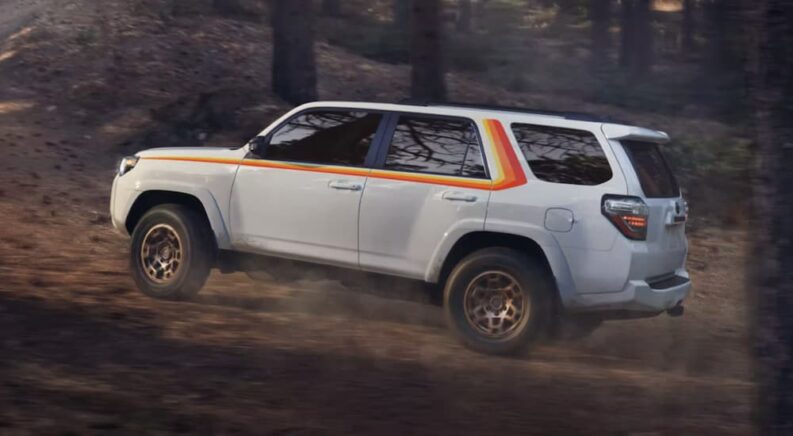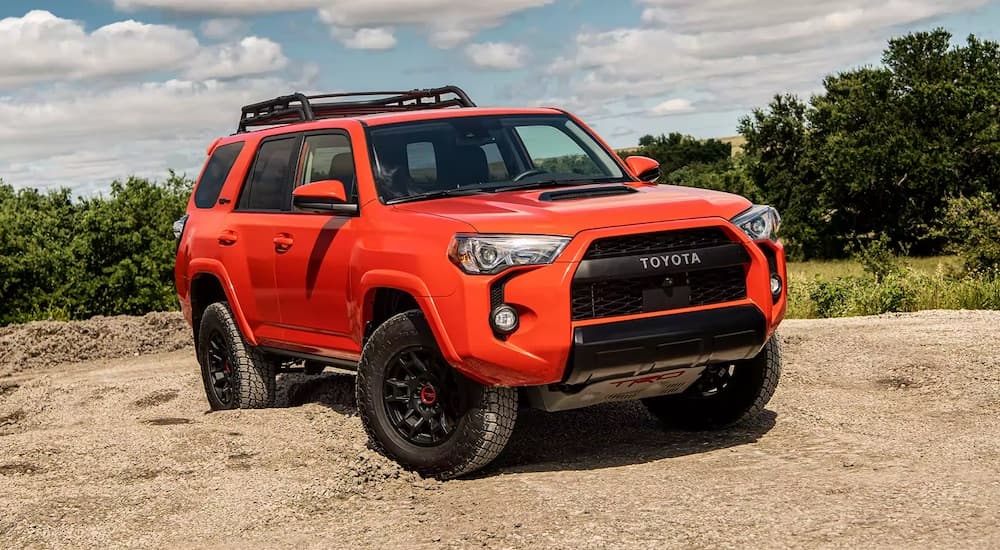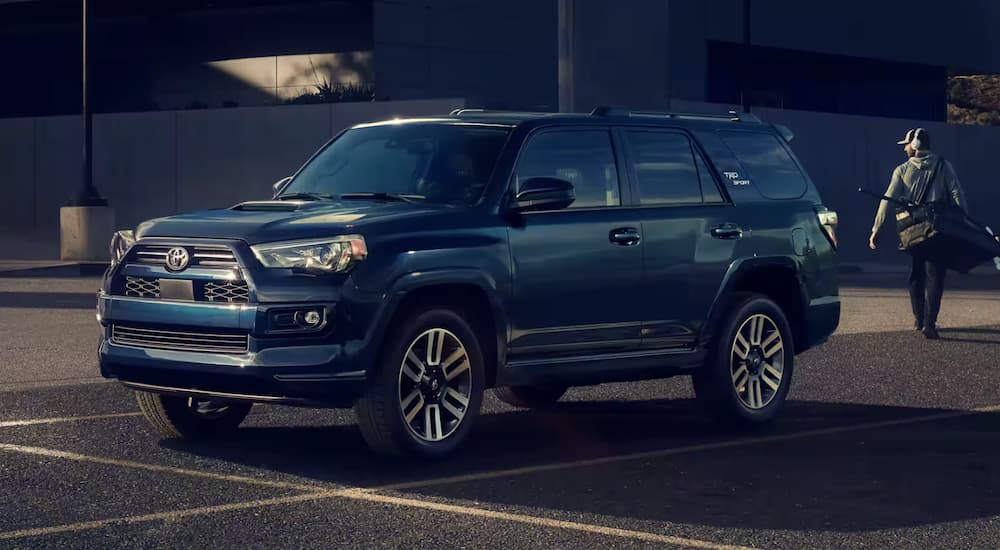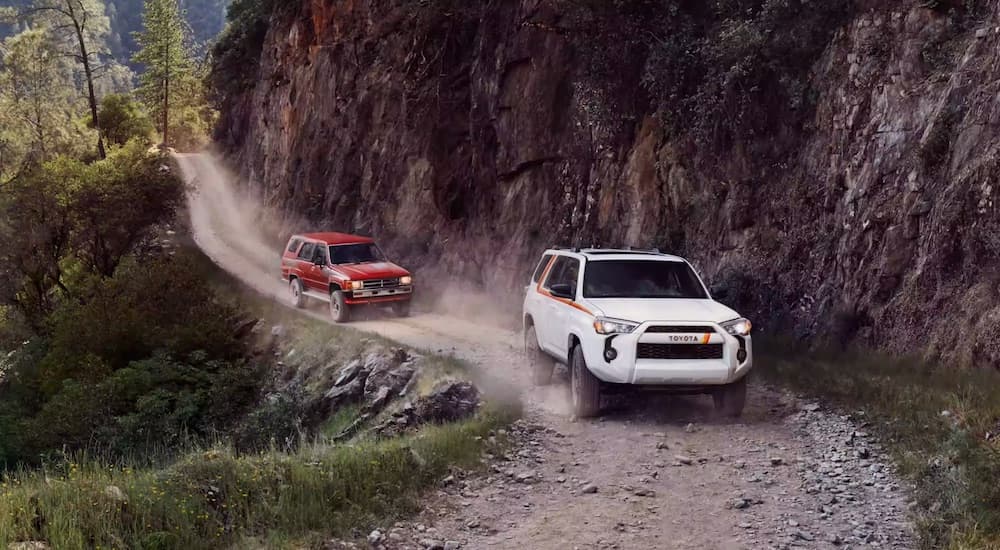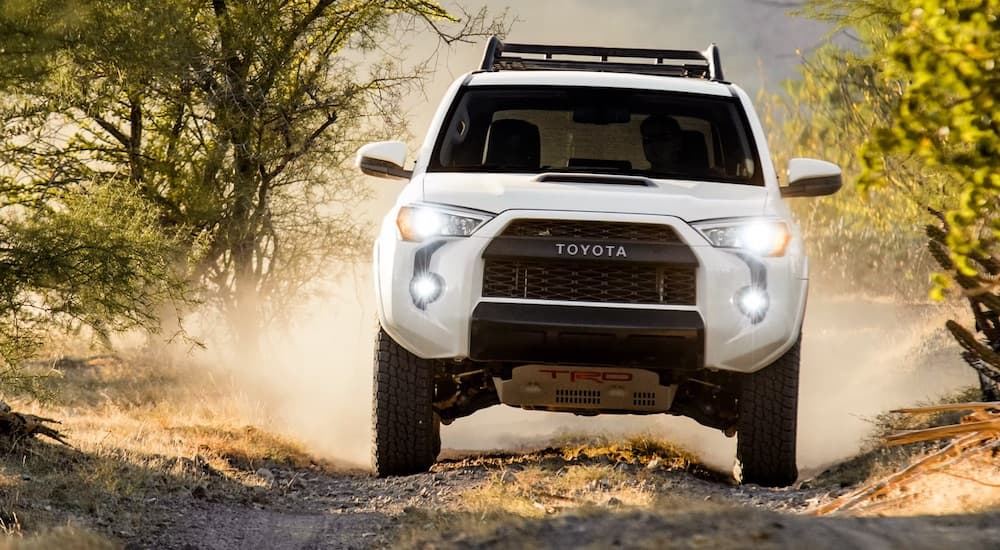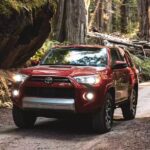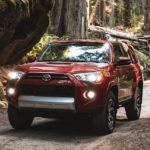Automotive adventuring may be far out of sight, but it’s rarely out of mind. Everywhere you look, even in the busiest downtown corridors, our streets are loaded with vehicles derived from intrepid thoroughbred overlanders. The crossover is, after all, a specialized derivative of the SUV. That said, few of the crossovers at your average local Toyota dealer actually call to mind that most exciting of automotive hobbies, laden as they are with concerns such as driving feel, fuel economy and modern luxuries. But some, mostly those whose name plates were there when the trails were broken in, have stayed true to their gallivanting off-road origins, few more so than the Toyota 4Runner.
Forty Years of Mud on the Tires
The 4Runner doesn’t really factor in conversations about “the first SUV.” The Chevy Suburban had been around for half a century. The Ford Bronco, Jeep Wagoneer, and International Scout all predate the 4Runner as well. The first use of the term “SUV” is firmly accredited to the introduction of the Jeep Cherokee in 1984. It’s unfair to leave the 4Runner out of the running, though, as it too hit the scene in 1984 after a most unusual proof-of-concept experiment.
Born from a desire to satisfy the needs of rural drivers who needed comfortable year-round transportation for their families as well as something that could handle the untamed wilds of America, the first 4Runner was actually called the Toyota Trekker. Built from 1981 to 1983, the 1500 or so examples of the Trekker were merely modified Hilux pickups, delivered straight to Winnebago to add a fiberglass roof and rear seats. The brilliant success of this experiment, dreamt up by an American Toyota dealer named Jack Safro, encouraged Toyota to dive into the new niche market and produce a purpose-built vehicle of their own, the 4Runner.
Forty years later, over four million 4Runners have been sold around the world, making it as popular as the Chevy Camaro. It’s at the absolute height of its popularity. The 2018-2021 model years are the best it’s ever had, despite the current generation being released all the way back in 2009. How is it that a car on such an old platform, one which has been consistently rated 4/10 by Car and Driver year in and year out, is enjoying the best years of its history? Let’s dig a little deeper to find out.
A Walk in Tough Shoes
The 2023 Toyota 4Runner gets a lot of flak from automotive journalists whose focus is centered on performance numbers, technology features, and luxury. Fourteen years into its run, the fifth generation 4Runner doesn’t have much of that, hence its consistently low ratings as a mid-size SUV. The powertrain is undersized, slow to respond and inefficient. The infotainment would have been poorly rated a decade ago, never mind by modern standards. Materials are cheap and hard, and before 2023 it didn’t even offer ventilated seats, despite a top-end sticker price in the mid-$50,000 range. Heck, the fourth generation 4Runner offered a V8 and greater towing capacity with similar fuel economy, and for a tenth of the price. So why would anybody want anything to do with a modern Toyota 4Runner?
Far as I can tell, there are four reasons:
- They like the basic and proven design
- They love off-roading but want road comfort
- They need capacity but dislike crossover styling
- They want one of the market’s most capable and lowest cost-to-own all-arounders
As Bulletproof as Rock Keats
Review after review of the 4Runner inevitably includes the adjective “bulletproof,” to the extent that I’d personally rather use any other word to make the point. This vehicle’s lineage is indomitable. Invulnerable. Indestructible. Remember, Top Gear once dropped a Hilux from the top of a building being demolished and drove it into the ocean, and it survived. That’s the car the 4Runner was based on.
Despite having a 20-year-old powertrain design with a five-speed transmission which only gets 17 mpg and 270 hp, the 1GR-FE–a variant of which is in my IS 250, ticking strong at 160,000 miles–is one of the most durable blocks in the industry. One of its most common “problems” is water pump failure at or around 150,000 miles, a $600 fix on a bad day. When people talk about the most durable cars on the road, the 4Runner (and its close relatives, the Tacoma and Land Cruiser) absolutely deserve some air time. The average 4Runner has a 40% chance of seeing 250,000 miles, tenth-best in the entire automotive industry, and this proven powertrain is one of the most important reasons.
The story is similar on the inside. The dashboard and center stack layout are loaded with big buttons and chunky dials that can easily be used with gloves on, something you might want to do if you live in a place that can get frost anytime between Labor Day and June. The infotainment, despite poor graphics and slow response, is easy to use, the opposite in every way to the infotainment experience on other current Toyotas (and in many other brands, according to reviewers).
In a nutshell, it may be old and simple, inside and out, but some folks like the 4Runner specifically because it’s basic and bulletproof.
Jack of All Trades
Some midsize SUVs have really good driving dynamics, maybe not in the sporting sense, but because they’re comfortable and easy to handle. Toyota’s own Highlander or the Honda Pilot come to mind. Those are unibody vehicles with little to no genuine trailblazing credibility, but stout reputations as comfortable, capable family haulers. Others are optimized for off-roading, such as the Ford Bronco or Jeep Wrangler, with notoriously fussy road manners stemming from their knobby tires and soft, high-travel suspensions paired with stiff body-on-frame construction.
The Toyota 4Runner walks the line between the two extremes, satisfying the driver who loves a good off-roader but holds road comfort as a high priority as well. The off-roading bona fides are impressive enough. All models have more than nine inches of ground clearance and locking differentials (limited slip rear with 2WD, electronic locking rear for part-time 4WD, and a locking Torsen center diff for full-time 4WD Limited trim). The TRD Off-Road and TRD Pro trims are especially impressive with multiple drive modes for different terrain types, CRAWL mode (a low-speed cruise control with five speed settings), and a camera system for monitoring obstacles near the vehicle, not to mention their advanced suspension systems.
TRD Pro’s FOX shock absorbers get a lot of attention, but the best system just might be the Kinetic Dynamic Suspension System (KDSS) found on the TRD Off-Road trim. KDSS features two sway bars, one front and one rear, installed with several clever deviations from the norm which optimizes their performance under all conditions. Here’s how it works.
Unlike normal sway bars, fixed to the vehicle frame and linked to the suspension at the free ends, KDSS’s large stiffeners are connected directly to the lower linkages of the front and rear suspensions. KDSS allows the pivot points, attached to the frame, to “float,” with the passenger side linked by a rigid bar and the driver side connection made by a hydraulic cylinder.
This arrangement is the same front and rear. The hydraulic cylinders are connected, which is how the system is then able to work its magic. Though there are some complex electronics involved to dampen the system, its premise is entirely rooted in hydraulic mechanics.
Imagine making a hard right turn on the road. You might expect the front KDSS cylinder to compress and allow a ton of body roll, as the vehicle’s weight leans on the driver’s front tire. But that would force hydraulic fluid into the rear KDSS cylinder, which is also experiencing compression since it’s on the same side of the car. As a result, and with a little help from the electronics to compensate for the slight deltas between the front and rear, the entire system firms up like steel. The resulting body roll is minimized thanks to the larger-than-average stabilizer bars.
Now let’s flip the situation around. The truck is off-road, and the driver’s side is attempting to clear a large boulder while the passenger side has no obstacles. With a stiff stabilizer bar in place, the 4Runner would tip heavily and lift the rear driver’s side wheel off the ground. But with KDSS, all four wheels can stay perfectly in touch with the earth. That’s because while the front piston is still experiencing compression in this case, the rear cylinder is under tension, while the wheel is at risk of being lifted off the ground. Instead of stiffening the ride, the sway bars fall completely limp as this pressure imbalance allows hydraulic fluid to flow freely to the rear KDSS cylinder (again, with the electronics intervening to keep things under control as-needed).
The effect is that of a spontaneous sway bar disconnect and reconnect, without any driver input needed. That’s how the same system which takes TRD Off-Road 4Runner’s off-roading capabilities over the top also makes them better on-road handlers than other similarly-capable vehicles, making the 4Runner perfect for balancing frequent road use with occasional serious off-roading.
4Runner 4Ever
The Toyota 4Runner is the ultimate compromise between mid-size SUV cost, full-size SUV style, off-road prowess, and on-road comfort. It’s got tons of space for stuff (or just enough space for tons of people), has a tremendously diverse trim lineup, and never seems to quit. This identity – and Toyota’s success at honoring it – has made it one of the industry’s most enduring and versatile designs.
That’s why, even though it makes 17 mpg and has an ancient infotainment system even in the $50,000 range, its popularity only continues to grow. Sure, it’s thirsty, and pricier than rivals, but high levels of sustained interest and that interminable powertrain mean that the 4Runner’s overall ownership costs are expected to be lower than the competition. According to Edmund’s, similarly-priced Highlander, Wrangler, Bronco, and Traverse models are all expected to have a higher overall cost of ownership, including 60% higher maintenance and 20% greater depreciation, just over the first five years. If you don’t mind the emissions, that powertrain is an investment.
It’s the indomitable spirit of the Hilux, living on in the 4Runner, that makes Toyota’s off-roader one of the best values on the market. The marathon-running 1GR-FE powertrain and features such as the all-terrain-taming KDSS stabilizers are key to its identity as the market’s number one tough, go-anywhere SUV that’ll see you safely through any journey, even if it takes a while to get there.
That’s alright. The 4Runner isn’t about wild performance numbers. It’s about the innumerable destinations to which it could take you.
It’s about adventure, and stories, and memories made along the way.

